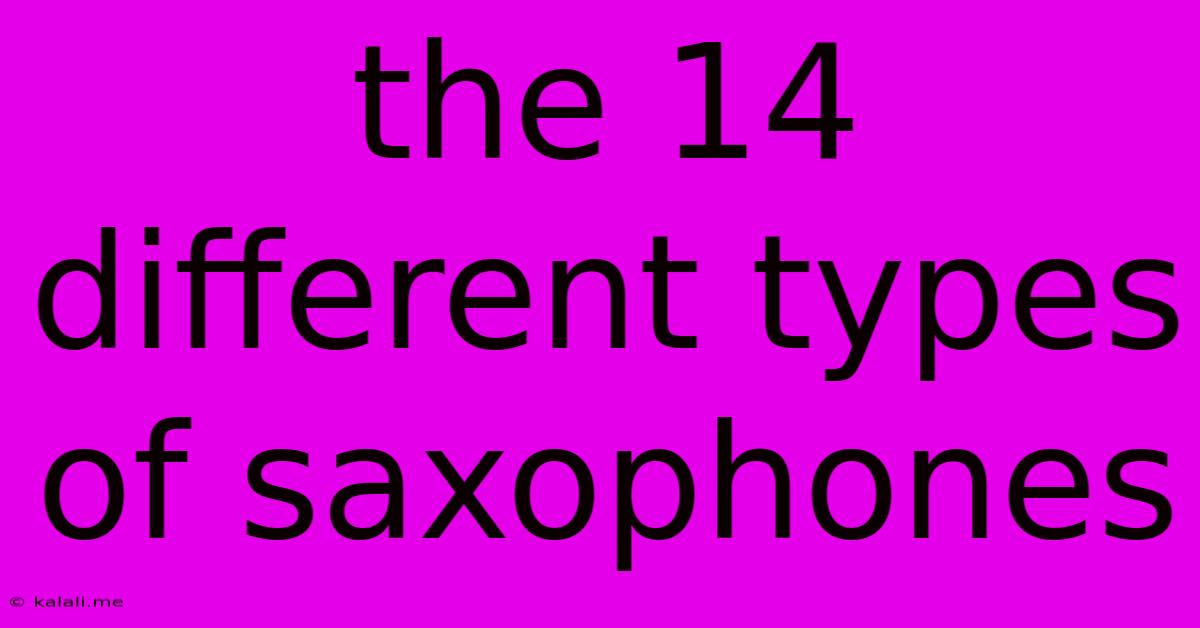The 14 Different Types Of Saxophones
Kalali
Jun 02, 2025 · 3 min read

Table of Contents
The 14 Different Types of Saxophones: A Comprehensive Guide
The saxophone, a captivating instrument known for its expressive tone and versatility, boasts a surprisingly diverse family. Beyond the familiar alto and tenor saxophones, lies a world of less-common but equally fascinating instruments. This guide explores the 14 different types of saxophones, detailing their characteristics, range, and typical uses. Understanding this variety helps appreciate the saxophone's rich history and its continued evolution in musical genres worldwide.
Understanding Saxophone Classification
Saxophones are primarily categorized by their size and pitch, directly influencing their timbre and register. The key differences lie in the length of the instrument's tubing, affecting the overall sound and the notes it can produce. This impacts their role in different musical ensembles and styles, from classical orchestras to jazz combos.
The 14 Saxophone Types: A Detailed Overview
Here’s a breakdown of the 14 saxophone types, ranging from the most common to the rarer variations:
Soprano Saxophones:
- Straight Soprano Saxophone: This model, often resembling a clarinet, features a straight body and is usually played with a neck strap. It possesses a bright, clear tone, often used in classical and jazz settings.
- Curved Soprano Saxophone: A more compact version, the curved soprano saxophone is easier to handle and offers a slightly different tonal quality compared to the straight model.
Alto Saxophones:
- Alto Saxophone (Bb): The most popular saxophone, favored for its rich, warm tone and comfortable playing posture. This is a ubiquitous instrument in diverse genres, including jazz, classical, and pop.
Tenor Saxophones:
- Tenor Saxophone (Bb): A larger instrument with a deeper, more resonant tone than the alto. The tenor sax is a staple in jazz, R&B, and funk music.
Baritone Saxophones:
- Baritone Saxophone (Bb): The largest and lowest-pitched of the commonly used saxophones. It contributes a powerful, robust sound to big bands and other ensemble pieces. Often used in orchestral settings and in jazz, as well.
- Contrabass Saxophone (Bb): A very large and rarely encountered saxophone. Its deep, powerful tone is used primarily in experimental music and specific orchestral arrangements.
Other Less Common Saxophones:
- Sopranino Saxophone (Eb): A small saxophone with a bright, high-pitched sound. It's not widely used, but finds its place in specialized musical contexts.
- Bass Saxophone (Bb): This instrument, larger than the baritone, is an essential part of larger jazz and classical ensembles, providing a foundation for the lower register.
- Sub-Contra Bass Saxophone (Bb): An exceptionally large and uncommon instrument with a very low pitch and imposing presence. Its use is highly specialized.
- Double Contra Bass Saxophone (Bb): This even larger version of the sub-contra bass is one of the rarest saxophones. Its deep, low register makes its use primarily experimental and limited.
- C-Melody Saxophone: While not strictly a different "type," the C-melody saxophone is historically significant. It was designed to play in the same key as melody instruments in smaller ensembles, therefore often needing no transposition. It’s largely a historical instrument.
- Soprano Saxophone (C): A less common variant of the soprano saxophone, offering a slightly different tonal character. Used in specialized classical and experimental works.
- Alto Saxophone (Eb): Less common than the Bb alto saxophone, this variant offers a slightly altered pitch.
- Tenor Saxophone (C): Another less-common variant, offering a unique tonal quality when compared to its Bb counterpart.
Conclusion
The saxophone family’s diversity is a testament to its enduring appeal. From the familiar sounds of the alto and tenor to the rarities like the double contrabass, each saxophone offers a unique voice, enriching the vast landscape of musical expression. Understanding these differences allows for a deeper appreciation of this versatile and captivating instrument.
Latest Posts
Latest Posts
-
Who Was The Homeless Woman On Sons Of Anarchy
Jun 04, 2025
-
White Spots On My Rose Bush Leaves
Jun 04, 2025
-
Can Others Ride The Drakewarden Drake
Jun 04, 2025
-
Is 3 7 Gpa Competitive For Grad School
Jun 04, 2025
-
How To Say Is In Latin
Jun 04, 2025
Related Post
Thank you for visiting our website which covers about The 14 Different Types Of Saxophones . We hope the information provided has been useful to you. Feel free to contact us if you have any questions or need further assistance. See you next time and don't miss to bookmark.